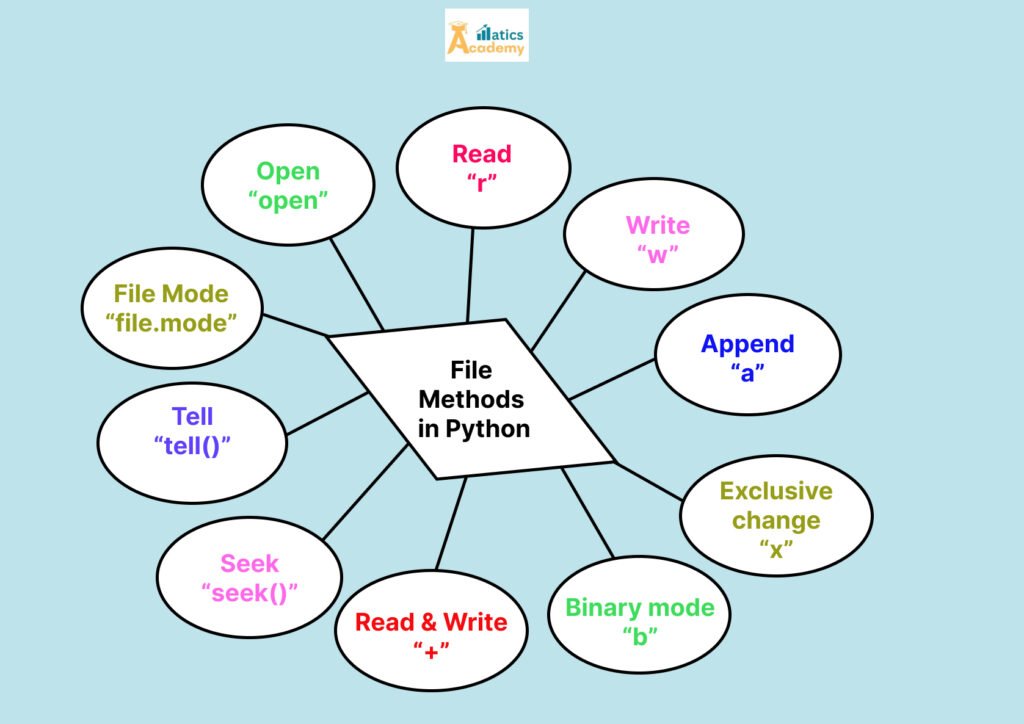File Methods in Python is one of the most important concepts in Python programming. Whether you’re developing a web application, building a data pipeline, or managing logs, working with files is a crucial skill. Makes it incredibly easy to read, write, and manipulate files with its built-in File Methods in Python. In this article, we’ll dive deep into File Methods in Python, complete with examples and best practices.

What is File Handling in Python?
File handling allows programs to interact with files stored on a computer whether it’s reading from them, writing to them, or appending new information. Python’s file handling system is simple yet powerful, offering various File Methods in Python for different file operations.
How to Open Files in Python
To interact with a file, you first need to open it. Python provides the open() function to achieve this. The basic syntax is:
file = open('filename', 'mode')
File Modes in Python
| Mode | Description |
|---|---|
'r' | Read mode (default). Opens the file for reading. |
'w' | Write mode. Creates a new file or overwrites the existing one. |
'a' | Append mode. Adds data to the end of the file. |
'x' | Exclusive creation. Fails if the file already exists. |
'b' | Binary mode. Used for non-text files like images. |
'+' | Read and write mode. Allows both operations. |
Example: Opening a File
file = open('example.txt', 'r')
print(file.read())
file.close()
Reading Files in Python
1.read()
There are several File Methods in Python to read data from files:
with open('example.txt', 'r') as file:
content = file.read()
print(content)
2. readline()
This is a File Methods in Python to Reads one line at a time.
with open('example.txt', 'r') as file:
line = file.readline()
print(line)
3. readlines()
Reads all lines and returns them as a list.
with open('example.txt', 'r') as file:
lines = file.readlines()
print(lines)
Writing and Appending to Files
You can create or modify files in Python using write() and append() methods.
1.Writing to a File
The write() method overwrites the content of a file.
with open('example.txt', 'w') as file:
file.write("This is a new line of text.")
2.Appending to a File
The append() method adds content to the end of a file.
with open('example.txt', 'a') as file:
file.write("\nThis text is appended.")
The Power of the with Statement
Using the with statement is the recommended way to handle files. It automatically closes the file after operations, ensuring no resources are left open.
Example: Using with
with open('example.txt', 'r') as file:
print(file.read())
Benefits of using with:
- No need to call
close(). - Prevents resource leaks.
- Cleaner and more readable code.
File Attributes and Other File Methods in Python
File Attributes
file.name: Returns the file’s name.file.mode: Returns the mode in which the file was opened.file.closed: Checks if the file is closed.
Other Useful File Methods in Python
seek(offset): Moves the file pointer to the specified position.tell(): Returns the current position of the file pointer.flush(): Forces the data to be written to the file immediately.
Example: Using seek() and tell()
with open('example.txt', 'r') as file:
print(file.read(5))
print("Current position:", file.tell())
file.seek(0)
print("After seeking:", file.read(5))
Handling Errors in File Operations
Errors during file operations are common. Python’s try...except block ensures smooth error handling.
Example: Handling Missing Files
try:
with open('nonexistent.txt', 'r') as file:
content = file.read()
except FileNotFoundError:
print("File not found. Please check the file name.")
Working with Binary Files
Binary files store data in binary format, often used for images, videos, and executables.
Example: Reading and Writing Binary Files
# Writing binary data
with open('image.jpg', 'rb') as file:
data = file.read()
with open('copy.jpg', 'wb') as file:
file.write(data)
Best Practices for File Methods in Python
- Always use the
withstatement for opening files. - Validate file paths before accessing them.
- Use error handling (
try...except) to manage file-related errors. - Close files properly if not using the
withstatement. - Avoid hardcoding file paths; use libraries like
osfor dynamic paths.
Conclusion
File Methods in Python is a straightforward yet powerful feature that allows developers to perform various file operations seamlessly. By mastering file methods such as read(), write(), and append(), you can efficiently handle files in any Python application. Remember to follow best practices for error handling and resource management to make your code robust and efficient.
It’s Code Time !Let’s Check it Out
Interview Questions
1. What are the different file modes in Python, and how do they differ?
- Company: TCS (Tata Consultancy Services)
- Answer:
Python provides several file modes for opening files:'r': Read mode (default).'w': Write mode (overwrites the file).'a': Append mode (adds to the end of the file).'r+': Read and write mode (file must exist).'b': Binary mode (e.g.,'rb'for reading binary files).'x': Exclusive creation mode (fails if file exists).
2. Explain the use of the with statement in file handling. Why is it preferred over manually closing files?
- Company: Capgemini
- Answer:
Thewithstatement is used to manage file operations in Python. It ensures that the file is automatically closed after its block of code is executed, even if an exception occurs. This prevents resource leaks and makes the code cleaner.
Example:
with open('example.txt', 'r') as file:
content = file.read()
3. How can you read a large file line by line in Python? Why is this method preferred?
- Company: Infosys
- Answer:
To read a large file efficiently, you can use a loop with thereadline()method or iterate directly over the file object:
with open('largefile.txt', 'r') as file:
for line in file:
print(line.strip())
This method is memory-efficient because it processes one line at a time instead of loading the entire file into memory.
4. What is the difference between tell() and seek() File Methods in Python file handling? Provide examples.
- Company: Wipro
- Answer:
tell(): Returns the current position of the file pointer.seek(offset): Moves the file pointer to a specified position.
with open('example.txt', 'r') as file:
print(file.read(5)) # Reads first 5 characters
print(file.tell()) # Returns 5
file.seek(0) # Moves pointer back to the start
print(file.read(5)) # Reads first 5 characters again
5. How would you handle file-related exceptions in Python, such as when a file is not found?
- Company: Cognizant
- Answer:
To handle file-related errors, use atry...exceptblock. - For example:
try:
with open('nonexistent.txt', 'r') as file:
content = file.read()
except FileNotFoundError:
print("The file does not exist.")
Quizzes
Let’s Play With File Methods in Python
Question
Your answer:
Correct answer:
Your Answers
